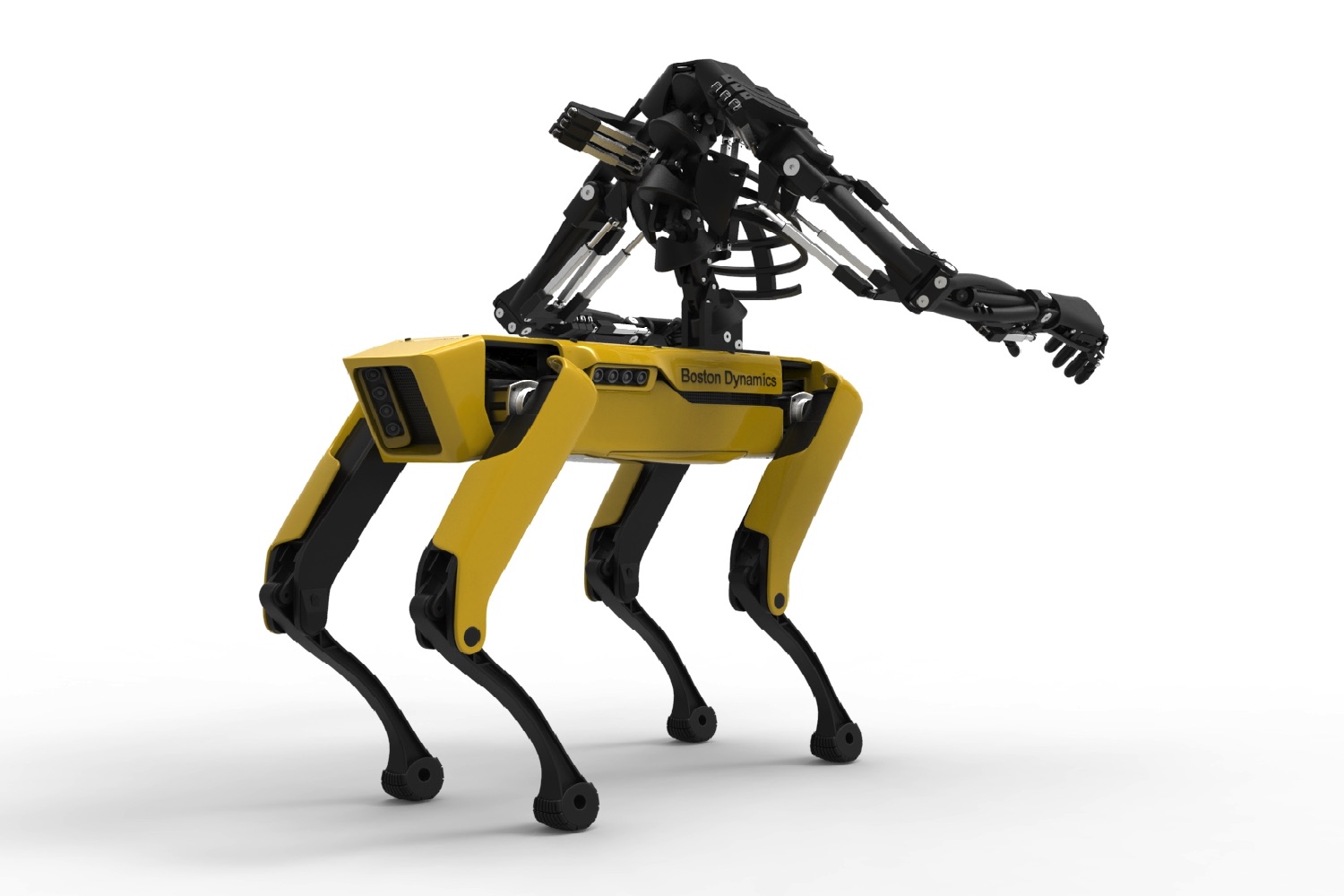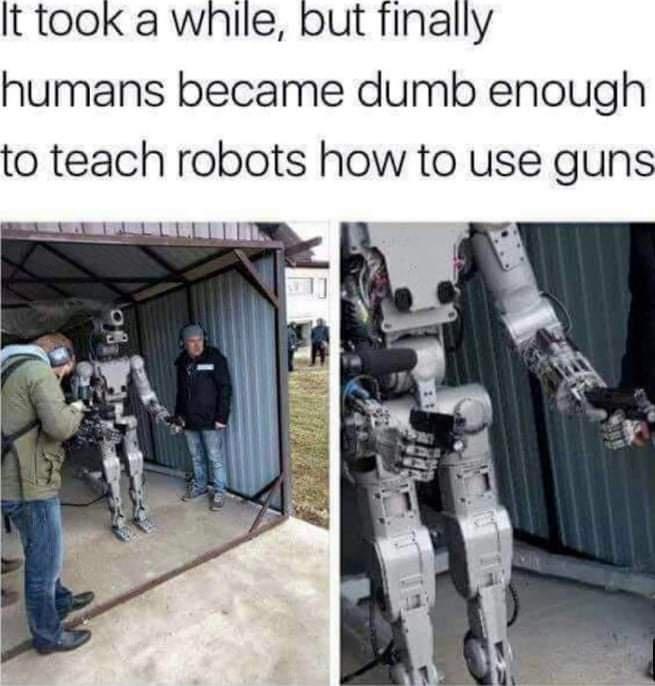…replacing the previously hydraulic version.
Insert obligatory welcome statement here.

So glad they selected this super not creepy intro.
I think they specifically chose that to display that it has no “forward” axis, robots don’t need to be 100% anthropomorphic and follow our biological limitations, this is a very significant evolution in design that will allow for better mobility
I’d go further to argue that it’s very necessary for robots to have even more mobility such as wheels to take advantage of momentum and increase efficiency. There’s a reason the wheel was invented, things like bicycles, wheelbarrows, etc.
The ANYmal wheeled legged robot is an example of that.
https://newatlas.com/robotics/anymal-swiss-mile-quadruped-wheeled-standing-robot/
Yes, very good point!
I wonder if someday in the future we might use reinforcement learning to iterate over different mechanical designs to explore even more exotic combinations of wheels, springs, hydraulic pistons, steel wires, legs and joints (optimizing for metrics like mobility etc). I even wonder if flexible joints made out of hard rubber could offer any advantages on bipedal motion
They might be able to ride bikes at some point.
I think the benefits to making them humanoid are underrated in this comment section.
T-001
Need to find out how to fight it, and kill it.
STEP 1 : Make friends with another one .
(If step one failed kill yourself in a painless way before getting crushed )

It looks like an improvement 😔. I mean fuck! I can’t even limbo that low much less get up from 0 to upright folding my legs around like that. But my face lamp is pretty bright! Just upgraded to LEDs and now I’m like a walking sun. I think they just copied me like that. And I got two ears not just one lowly antenna. So that’s not an upgrade.
Now they just need a silicone dildo, some silicone glue and a famous pornstar actress. That would sell a lot of droids this Christmas. Lots of Jewish, Jehovahs, Catholic, Christian, Protestant, Muslim men would be very interested…and women too. Specially if they come preprogrammed or programmable for special work like that.
This is probably the best way to get up if your joints can fully rotate. If you look closely, the legs are exactly below the center of mass when they touch the ground, making it easy to push upwards without falling over.
Humans just have to make complicated contortions or jump up because our joints are inferior (there are no slip rings for blood vessels).
That broke my brain for a second
I can probably do that too if I dislocate my hip bones
I want to see more of this future terminator.
Samara
Only got one question for ya here fellas, can it fuck?
Stretch has reach, Atlas had flexibility.
The orifice is working on that module
I’m getting really tired of that metric.
Like, human performance has a very wide range and scope.
My car “exceeds human performance.”
My toaster exceeds human performance for making toast.
Michael Phelps exceeds the human performance of myself in a pool.
I exceed the human performance of any baby.
This just tells me that the robot is more able at something than the worst human at that thing.
Exceeds the very limited parameter we used to define as “human performance.”
“Look, this robot’s arm can spin 360°! It exceeds human performance!”
Ok, can it get a glass out of the cabinet, put ice cubes in it, fill it with water and bring it to me?
I think you could have picked a more difficult metric, this is something i’m pretty sure the BD robots can actually do.
In a random home, then. A human would know what a refrigerator is, where the ice is (dispenser or freezer), check cabinets for cups/glasses, and operate the sink. The BD bots would likely have to have everything pre-mapped, RFID’d and/or programmed.
Waiting any minute for Musk to come out and say how Tesla is the most advanced robot manufacturing company still, because he can’t stand not being in the spotlight.
soon things like this will be everywhere in our lives, on subscription, and can turn into police or military at any time like an agent smith. sleep tight!
Or just running down the street looking for an electric outlet to plug into
I mean, the planet’s dying, but ok. At least we’ve got robots that “excced human performance” in making their overlords profits. Imagine if these scientists were putting their efforts to real use.
Lemmings reading you right now:

The planet is fine, humanity is dying. But that’s ok.
Is it, though?
Yes. The planet doesn’t give a single fuck. It went through many extinction level events and it’s still here.
At least they aren’t only working on preventing hair loss and prolonging erections
Is there a difference?
Paraphrasing a joke from a movie called “Idiocracy”
I was already thinking this reminded me of The Talos Principle but your “the planet is dying” comment makes it even more close of a match. Those games are awesome.
Cancer rope-a-doping us with robots and AI.
I never knew I needed Boston Dynamics to build a skinwalker, but they knew
“What should we include when we build our humanoid robot?”
“It should stand up in the most unnerving way possible.”
Jesus Christ, it’s like they made a new RoboCop out of the girl from The Ring

Your mother makes robots in hell.
Okay somebody probably knows better than me, but what is the advantage of humanoid robots? Why are people kinda, on this, now? It feels very 20th century, as an idea. It’s pretty cool, but I don’t understand why this would be necessary compared to just like, specialized normal robots that do specialized normal tasks. It seems more efficient, if you wanted a robot to, say, do the dishes, to make a robot that just does the dishes, instead of making a robot in the shape of a person that does the dishes. The one that’s in the shape of a person is maybe more broadly applicable to human contexts, software notwithstanding (which does seem like a major hiccup). But it’s not as though there’s like, an upper limit on the amount of robots which we can have, in total. You could just make more robots, and make them specialized for certain tasks, like stocking shelves or whatever, and that would probably be easier, I would think, than making one robot to rule them all. Like, one robot, with ostensibly an on-board computer and on-board batteries so it’s as universal as possible.
It gives me self-driving car vibes, where we could’ve had them in the 50’s if everyone was willing to install metal spikes in the ground every however many feet ahead, but then that maybe doesn’t make any sense, because it’s just kind of a shitty train or tram. Basically, that nobody’s willing to front the cost of infrastructure for anything anymore, so we have to make like, a universal device, and end up quintupling the total cost while making a solution that is either less efficient or doesn’t exist.
Also, what’s the point of the legs? Is it supposed to go outside, or go up stairs better? We already have pretty efficient wheeled vehicles capable of doing that in most public spaces, or, we’re supposed to, anyways, they’re called wheelchairs. What do we need this guy to walk around for?
Edit: So far, what I’ve gotten is ladders, and the scalability of a humanoid design vs other kinds of designs.
For ladders, I think you could probably tackle that with a similar set of constraints what you might need for a stair climbing robot, maybe just with a couple heavyweight anchors inside of it and some gearing or something. Use the robot’s big arms, the manipulators, to climb like normal, and then use the bottom wheels to sort of ratchet the robot up. Probably that could work on most ladders with some clever engineering. Could maybe also run a cable from the top of the ladder to the bottom and then have a system where the robot rappels up and down for lots of ladders, but yeah.
I don’t think you end up spending all that much on a robot that has wheels vs legs, and I think probably the increased efficiency would be worth it if you want like a generalized robot here. Might be wrong, maybe a roboticist can tell me no, but I dunno. As far as engineering goes it doesn’t seem any more complicated than legs. Legs seem better for, offroading, basically. Which are why lots of animals use them, cause animals don’t have roads.
For the versatility and scalability thing, I dunno whether or not it’s more or less efficient still. While a steam cleaning room does require some amount of consideration to build, I would think that you could really get the price down from the tens of thousands of dollars required for this kind of robot to perform a similar job. Especially if you built it that way up front, retrofits might be much more expensive considering how many bathrooms aren’t built correctly. Or you could go with a kind of hybrid approach, which I totally forgot about, but would seem to make some amount of sense, especially for a larger building.
Maybe those savings build up over time, and you could just have a McDonald’s staffed by like three of these at once and only spend like 500,000 on it, which does seem like quite a bit to add on top of a McDonald’s opening costs. I’m assuming you gotta buy multiple to staff it as a whole and also that you have to buy multiple to have more battery capacity, but maybe one of these will come out with the clever innovation of a swappable battery if/when they come to market. I would definitely hope that’d be the case.
I’m not sure it works out economically. I’m not sure of anything here. These are just suggestions because I haven’t seen a lot of FUD on these human robots, except of the Terminator variety, which seems dumb.
I suppose my biggest difference here is just one of philosophy, mostly because I’ve seen it reflected in self-driving cars. You can make something that’s capable in any context. Wind, snow, rain, shine, heavy traffic, pedestrian traffic, intermodal traffic, different kinds of roads not created to a set standard by the state’s DOT. You can make a Swiss army knife, right. Maybe there are some economic and QoL savings there if you can do rideshares or do like, johnnycabs, right, if you can eliminate the desire for car ownership and status from the American mind. Maybe you can get all those cars out of parking lots as much as possible, and onto the road, doubling, maybe even tripling the amount of traffic as cars now move from one person going from one place to another place. Maybe you can also solve traffic, if you can get all the human driven cars off the road and totally automate everything so none of the cars ever hit each other or anyone, maybe you could try to do this piecemeal with autonomous vehicle only zones and surmount the nimbys with venture capital to buy a whole local municipality. Maybe you can balance the speed with the safety so we don’t have heavy traffic and we get places on time, but when a disaster strikes from ice buildup on the road in a random place, or leaves flying around your car, it doesn’t kill everyone. Maybe, you can get all this to not computationally require an energy cost collectively that rivals a medium sized European country. Maybe you can also solve the wireless communication issues that would plague this system, and maybe that allows you to simplify it instead of having every car be self-driving and predictable even though probably a bunch of different companies will be trying to get in on this and will be mingling in traffic, with different softwares.
Maybe you could also make a tram, though. Maybe you could have an electric folding bike you take on the tram. That’s also an option. That’s just infrastructural cost, and we could do that right now.
Neither of these solutions is necessarily better, right. I mean, in this case specifically it’s pretty apparent to anyone with half a brain that the trams are better quite obviously but like, as an analogue about humanoid robots, especially with the point taken about a variety of contexts as opposed to a single high friction context like cars, neither of these solutions are necessarily better. They entail different philosophies. One created a world around the thing, one creates the thing. One changes the world to suit the people, one changes the people to suit the world.
Is what I’m saying making sense, did I get my point across?
Because this makes it a drop-in replacement for a person. You need to go into a confined space with toxic gas? Your Wall-E-looking robot works great, right up until you hit a single step, god forbid a ladder. This robot could handle all of that, and turn the valve to shut off the gas or whatever.
Wheels need roads and paths. Legs can walk over just about anything.
Specialized robots are great at doing one thing and terrible at doing everything else.
General humanoid robots can traverse and operate in environments that were designed and built for humans, and vice versa.
There’s a reason evolution settled on the tetrapod body plan. It’s very versatile. Walking on two legs just adds to that versatility.
It’s easier to build a specialized robot for one task than to create a general purpose robot to handle that task. However, as the technology matures, I think it becomes much more practical to create a general purpose robot that’s capable of performing millions of tasks than to create millions of different specialized robots. Not only is that far less to design, source parts for, build and maintain, but it also makes it much easier to repurpose them as needs change. The same basic design can potentially be used for factory work, household chores, new construction, search and rescue operations, food service, vehicle maintenance, mining, caring for kids/elderly/pets, building and maintaining other robots, etc. We’re not there yet, but that’s where this kind of technology could potentially take us.
The advantage of a mostly humanoid robot is that it’s versatile and can use existing solutions built for people. Yes, you could replace the legs with wheels or treads, and you’d probably be just fine for most functions with a Johnny 5 type design, but there will still be exceptions. Being able to climb up or down a ladder for example means that you don’t have to engineer a solution to deal with getting onto a roof or down into a tunnel system. We’ve already spent thousands of years solving those problems for humans.
Exactly. In a factory you can create an automated line that runs as long as you need. Or you can spend 1.5-2x that and get an automated worker that can work any of the lines you already have.
Also a lot of tasks that take one person would take several robots. Modify and inspect part-pack part-move pack to pallet for example
Operating in environments made for humans, as well as alongside humans.
Say you have a remote hydroelectric dam that needs inspecting. You might need to walk stairs, climb ladders, open doors. We’re neither going to re-build all the dams we already built, nor build new ones to be wheelchair-accessible.
All this R&D on a drone that can open doors?
War and policing. You’re dug into a foxhole/bunker with your bolt action rifle, and a few thousand of these things come marching along. Or you’re protesting the party in power, so a few hundred of these automated law enforcement officers get sprung loose to “keep the peace”
and a few thousand of these things come marching along.
You do understand how expensive and impractical that would be, right? Training a thousand 18-year olds to handle anti-material rifles is going to be far, far cheaper than doing maintenance on a hundred of these robots.
Or you’re protesting the party in power, so a few hundred of these automated
You don’t need humanoid robots for that.
Also battery life, You can give a human a couple of sandwiches and they’ll go all day, the robot probably needs a 20kg battery and still won’t go more than 8 hours without charging. Its actually one of the kind of mindblowing things about organic systems, A whole human body runs on less power than just the control unit for one of these robots (assuming its similar to a mid range laptop) let alone the motors.
I have a very simple test for these things when it comes to military stuff - would this or that piece of tech have proved an obstacle to the NLF (you know… that organisation people insist on calling the "Viet Cong)?
And the answer for this robot is… only if the objective was to provide them with lots of fancy scrap metal.
Expensive and impractical today, yes. But we would say the same of every man, woman, and child having a supercomputer with the entirety of human knowledge in their pocket fifty years ago.
We have set up the world to be very usable and traversable by humans. A robot in that form would be able to go and do most things. Think of all the changes to places that needed to be made as part of the ADA. And those were for humans with relatively small changes such as wheels instead of legs.
I also question why they think it needs to have legs, especially only 2. The dogs seem to have way more stability on 4 legs. Why do they insist on making them appear human?
Centaur!

Yeah! That’s more like it!
Gimme the spider designs! I’d be good with both ghost in the shell and wild wild West spiders
Because if the abrahamic god made us from clay, we, who have the spark of divinity inside of us because we were made on his image, can also do it and will do it better because fuck sky daddy.
Internet is full of text and video about humanoid bipedal things performing tasks. There’s a lot of investment money gambling that LLMs + human-shaped robots can make an electric slave that an unskilled overseer can vaguely yell at and the robot can figure out what they meant and how to do it like a human can.
We are slowly, step-by-step heading toward visble androids.
Other people have mentioned flexibility in maneuvering around humanoid spaces, but there’s also something to be said about bipedal balance. I can pick up a pack of shingles throw it on my shoulder climb up a ladder and put the shingles on a roof without having to be half of the size of a cherry picker lift. Nothing says they have to be exactly humanoid or even necessarily bipedal. For some jobs I could see something more tri-pedal, insectoid or even spider-based would be useful
Did you know there is an industry-standard mounting system for strap-on dildos? Just saying.
You really trust this thing’s fearsome actuators with your delicate starfish? Bold indeed.
You were thinking exactly what I was thinking!
Finally, a technology related post in the technology community.

The treasonous Automaton-sympathizing scum…
Were the others not fully electric!?!?! Like obviously they were but the title makes it sound like they built steampunk robots.
When they take over? They look super fun!
Seriously, Spotify should buy a bunch and launch pop up DJ venues. Put Skrillex out of a job.
I want to fight it.
Everyone has a plan until a pneumatic metal fist hammers them silly.
But this one’s electric
You’re completely correct, pneumatic sounded cooler. I know, I’m a complete scumbag.
When will people learn there’s nothing cooler than precision?
That’s a worthwhile question to ask, no doubt.
What if being hammered silly by a pneumatic fist is my plan?
🫦
Cheryl Tunt is that really you?!
It’s CAROL!
Hey I’m glad you know what gets you hammered, you do you ;)













